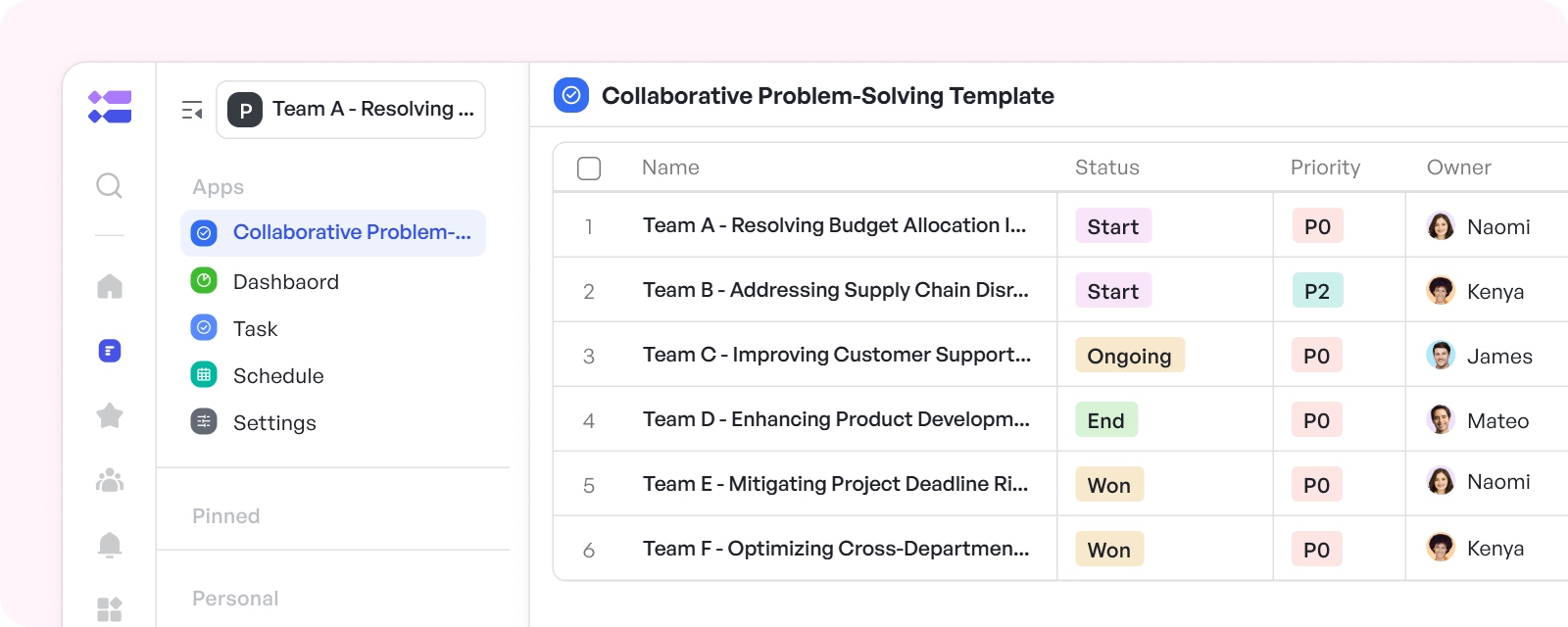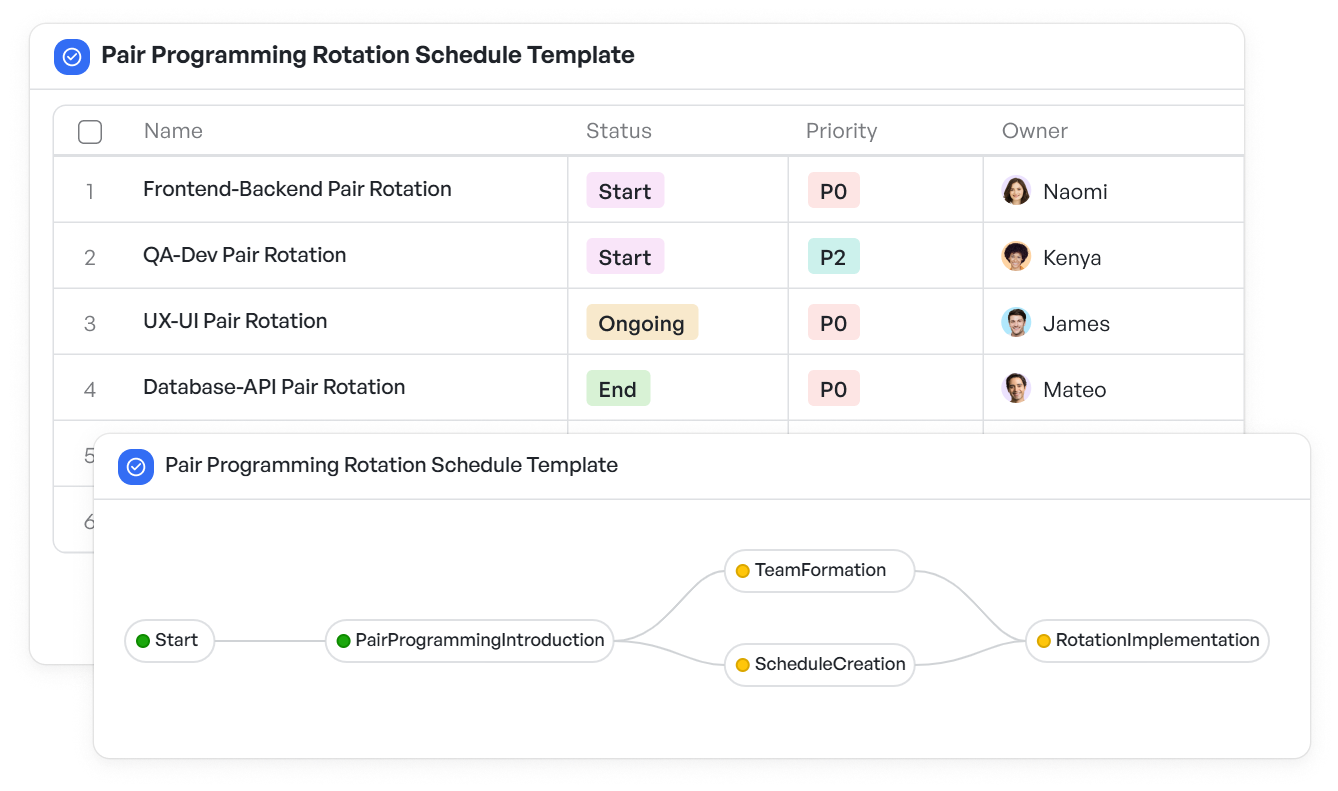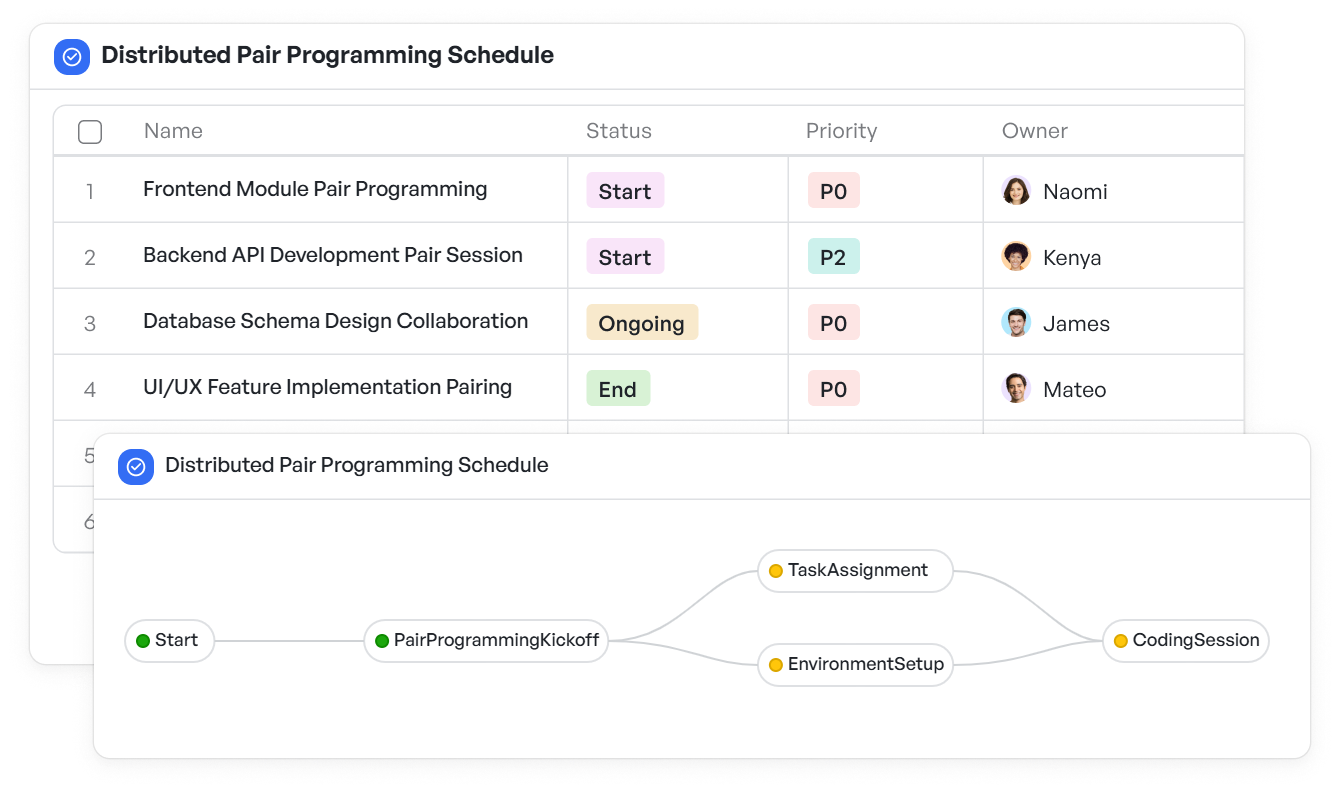How to Implement Pair Programming In Software Development

Pair programming is a development approach where two engineers work together at one workstation. One writes the code (the "driver") while the other reviews each line in real time (the "observer" or "navigator"). These roles frequently switch to maintain engagement and balance.
Although it originated from Extreme Programming (XP), pair programming has become popular across agile teams for its collaborative advantages and contribution to knowledge sharing.
In the following sections, we’ll break down the tangible benefits of pair programming for software teams, where it works best, how to implement it effectively, and what to watch out for.
3 Reasons to Use Pair Programming in Software Development
In fast-paced software environments, particularly within mid-market and enterprise-level teams, pair programming offers more than just productivity benefits. It promotes consistency, reduces errors early, and helps level up less experienced developers.
For engineering leaders, pair programming also serves as a cultural tool for fostering habits of collaboration, mutual accountability, and collaborative problem-solving.
 Structure technical discussions and resolve blockers faster during pair sessions
Structure technical discussions and resolve blockers faster during pair sessions1. Improved Code Quality
When two minds are involved in writing the same piece of code, bugs are caught earlier. This reduces the cost of fixing issues downstream and often results in cleaner, more maintainable code. In short, pair programming supports code quality.
You might be interested in: 👉Extreme programming and code quality
2. Faster Onboarding and Skill Transfer
Pairing a new hire with an experienced developer accelerates onboarding. The newer team member quickly learns codebase structure, naming conventions, and internal processes through context-rich discussions.
3. Real-Time Feedback Loop
Rather than relying on post-merge code reviews, pair programming integrates feedback directly into the development process. This minimizes rework and encourages active thinking during implementation. This in turn, helps you to easily debug with the help of pair programming.
Common Styles of Pair Programming in Software Development
Depending on the team’s size and complexity of the task, different pair programming styles can be adopted:
- Driver–Navigator: The most classic setup. One codes, one thinks.
- Ping-Pong Pairing: One writes a test, the other writes the code to pass it. Then they switch.
- Tour Guide: Ideal for onboarding, where a senior walks a junior developer through a new system.
- Strong-style pairing: The person with the idea gives instructions, and the other types it out.
To organize these effectively, use resources like the pair programming rotation schedule template.
 Plan structured pair switches and keep collaboration dynamic across your development team
Plan structured pair switches and keep collaboration dynamic across your development teamWhere Does Pair Programming in Software Development Work Best?
Pair programming is not meant for every task, but it does excel in situations like:
- Complex architecture or systems work
- High-risk code deployment (e.g., security, infrastructure)
- Exploratory development or prototyping
- Training sessions or onboarding periods
In mid-market or enterprise software companies, especially those working with mission-critical features, pair programming brings clear returns in these scenarios.
Although pair programming is effective in many areas, there are also instances where it is less effective.
Some of the situations include:
- Low-priority or repetitive tasks
- Tasks with no ambiguity or risk
- When both developers are burnt out or overloaded
In such cases, solo work or async collaboration is often more efficient.
Challenges of Pair Programming in Software Development
While pair programming offers clear benefits, it also comes with its own set of challenges that teams must address to make the practice sustainable and effective.
Developer Fatigue
Sitting together for long periods can be mentally taxing. A good practice is to take short breaks every hour and pair only for specific tasks rather than the whole day.
Personality Clashes or Imbalances
Some pairs may struggle with mismatched work styles. Rotating pairs regularly and setting pairing expectations ahead of time helps reduce friction.
Initial Slow Output
Compared to solo work, pairing may feel slower, especially for short, easy tasks. But over time, it reduces rework and improves code correctness, ultimately saving time.
Requires a Cultural Shift
Not all teams are ready for close collaboration. It helps to introduce pair programming gradually—starting with voluntary pairing sessions and setting clear pairing guidelines. Teams navigating hybrid or distributed setups may also benefit from extreme programming in hybrid models. It helps to introduce pair programming, starting with voluntary pairing sessions and setting clear pairing guidelines.
5 Steps to Implement Pair Programming in Software Development Effectively
pair programming can significantly enhance code quality and foster collaboration, but to truly reap its benefits, it's important to implement it effectively.
1. Define the Right Use Cases
Identify tasks where code correctness and context-sharing matter more than raw speed—like architectural decisions, new module setups, or infrastructure updates.
2. Use Visual Workflow Tools to Assign and Monitor Pairs
Teams benefit from tools that help assign pairs based on workload and visibility into who’s working with whom. Visualized workflows allow leaders to match engineers thoughtfully and track progress without micromanagement.
Platforms like Meegle offer templates that help you organize task ownership, dependencies, and timeline expectations, making it easier to integrate pair programming without chaos.
3. Rotate Pairs
Regular rotation prevents knowledge silos and helps engineers develop broader perspectives across the codebase. It also keeps energy and collaboration fresh.
4. Establish Ground Rules
Agree on norms: who drives, when to switch, and how to handle disagreements. Some teams like short daily pairing sessions. Others prefer long-form collaborations a few times a week.
5. Track Results Without Micro-Managing
Don’t measure pair productivity in lines of code. Instead, look at fewer bugs, better pull requests, smoother onboarding, and increased peer support.
Making Pair Programming in Software Development Sustainable
Pair programming works best when it's supported by long-term habits, not just one-off experiments. Here’s how high-performing teams make it part of their culture:
- Set the right expectations early: Align on when to pair, how often, and which tasks merit collaboration.
- Start with opt-in pilots: Let enthusiastic team members try pairing first, then expand as comfort grows.
- Rotate partners intentionally: Prevent silos and keep fresh perspectives across the codebase.
- Document pairing guidelines: Clarify pairing roles, switching frequency, and etiquette in your team handbook or onboarding.
- Share wins: Highlight moments where pairing improved outcomes (like faster debugging or onboarding).
- Review pairing practices quarterly: Use retrospectives to gather feedback and refine the process.
Visual Workflow Makes Pair Programming in Software Development Easier to Adopt
Pair programming needs clear task alignment and visibility. Tools that show who’s working on what—and how their work connects to a bigger project—make pairing less of a burden and more of a benefit.
That’s where visual workflow systems help. Instead of getting lost in spreadsheets or scattered tickets, you can visualize handoffs, responsibilities, and blockers. Everyone involved in a pair can see timelines, dependencies, and teammates involved.
You can also consider the distributed pair programming schedule template if you're managing remote teams.
 Remote teams pair effectively across time zones and maintain structured collaboration
Remote teams pair effectively across time zones and maintain structured collaborationEmpower Your Team, Elevate Your Code Quality
Pair programming, when used strategically, is more than just a coding technique. It’s an opportunity to foster collaboration, accelerate knowledge sharing, and improve code quality across your team.
By pairing developers with complementary skills and perspectives, teams can tackle complex problems with greater confidence and produce more maintainable, bug-free code. Beyond the immediate benefits of improved code quality, pair programming creates long-term value by building a stronger, more adaptable team.
Experience the Meegle difference—optimize your development flow and make pair programming more effective than ever.
The world’s #1 visualized project management tool
Powered by the next gen visual workflow engineRead More
Check All BlogsStart creating impactful work today



